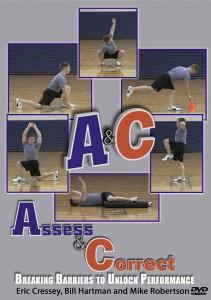My name is JP. I bought Assess and Correct a while back, and I have procrastinated in applying it. Now I am going through it and I am wondering: When implementing the corrective exercises, how often should I do them? And which ones should I do? Just the first ones recommended? When should I progress to the others? Should I do more than one in each category?
I have to admit that I have problems in most areas but some are bigger and have more consequences than others (like my hip flexors causing an anterior pelvic tilt and exaggerated low-back arch). Should I do more work in these areas? Or focus on one area in particular and do extra work on it?
I have been doing the warm up from Eric’s book Maximum strength (both the SMR and the exercises) for a while and it has been helping. I think this will help me get even better… should it be implemented in the same fashion? One exercise for each area prior to a workout?
I love the product and I am learning a lot; I’d just like some help with implementation and progression.
Thank you so much,
-JP
JP –
Great questions, and although I’m pretty sure I’ve answered them before, I hope this post will help you (and a lot of others) get more out of the product!
Let’s go through your questions, one by one.
When implementing the corrective exercises, how often should I do them?
The stock answer is always going to be “it depends,” but I’ll try to flesh this out a bit.
Obviously, Assess and Correct is first and foremost a warm-up product. The exercises we outline are geared towards addressing your movement limitations pre-workout, so that you get more out of the ensuing workout.
So the easy answer is “always do them before you workout,” but there’s more to it than that. I’ll address this in more detail below.
And which ones should I do? Just the first progression recommended?
This depends on how well you’re moving. Those with severe movement limitations will need to start with the most basic progressions, while others will be able to start in the middle, or even with the most advanced progressions.
The question becomes: What exercise you can do from a specific section with perfect form? When you answer that, you’ve found the exercise you should be performing.
When should I progress to the others?
Again, what level of progression you can perform while maintaining perfect technique? This is where you start.
With regards to progression, I would stick with a given progression for about a month, and then try the next level of progression. If you can do it perfectly (albeit with a limited range of motion, etc.), then stick with it. If you really struggle with that pattern, you may need to wait another month and then re-test.
Should I do more than one in each category?
You could do more than one in each category, but it comes down to how much more you’ll get out of the extra work. Rather than performing extra exercises pre-workout, I’d rather see you go through the entire warm-up/corrective portion of your program more frequently.
Instead of just pre-workout, maybe you could use this as an off-day training session, or something that you do in your free time to help improve your movement limitations.
Should I do more work on problem areas? Or focus on one area in particular and do extra work on it?
The answer to the first question is easy – yes.
But, I would again mention that simply performing the A&C stuff pre-workout might not be enough. Instead, try using this stuff throughout the day, or on off-days to get better results.
As well, keep in mind that a truly corrective strength/conditioning program should coincide directly with the results of you’re A&C program. That is if you have stiff hip flexors and weak glutes, you need to actually address those issues within your programming as well.
A&C is powerful, but it’s part of your training program – not your entire program.
I hope that helps. Best of luck with the program, and your training in general!
All the best
Mike
PS – If you’d like more information on how Assess and Correct can help you move and feel better, be sure to check out the website below.

